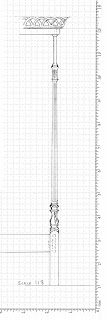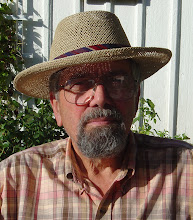Upwards of
forty years ago, my mother gave me a bundle of tools, an old roll of moth-eaten
green baize, holding a selection of ten woodcarving gouges and chisels, made by
Wm. Marples & Sons of Sheffield. William Marples established his company around
about 1830.
It grew steadily and for several generations Wm. Marples & Sons
was one of the largest and most highly respected edge-tool manufacturers in the
world. These carving tools had belonged to my grandfather, who passed away in
1963 at the age of eighty-six. I have a
vague memory of seeing in his house a plaque which he had made, of polished
dark wood, carved in bas-relief with grapes and vine leaves,. But I always thought this rather an odd hobby
for my grandfather, who, though a keen and knowledgeable gardener, was not, as
I remember, a man who otherwise worked with his hands. He was more bookish; in
old age a quiet, religious and thoughtful person living more a life of the
mind. This minor mystery was resolved for me when, more than a decade ago, my
daughter and I began to research our family history. Our efforts revealed that my grandfather’s
father and his father before him had been in the coach-building trade.
Furthermore, we found from the 1901 Census that my grandfather had chosen a
different career for himself. His occupation was then, (at the age of 24)
‘Solicitor’s conveyancing clerk’. My great-great-grandfather, James Clement,
born in 1823, was variously described in censuses and directories of the day as
a ‘Coachbuilder’ (1860), ‘Coach-maker’s Sumner’ (1871) and ‘Coach Trimmer’
(1881). At the same time, the occupation
of his son, my great-grandfather James Morton Clement is listed on the 1881
Census as ‘Coach Smith’. It could be that, much as in this sort of
manufacturing today, those involved learned to handle all the different jobs
required, although ‘Coach-maker’s Sumner’ is a bit of a puzzle.
My great-great-grandfather, James Clement,
born in 1823, was variously described in censuses and directories of the day as
a ‘Coachbuilder’ (1860), ‘Coach-maker’s Sumner’ (1871) and ‘Coach Trimmer’
(1881). At the same time, the occupation
of his son, my great-grandfather James Morton Clement is listed on the 1881
Census as ‘Coach Smith’. It could be that, much as in this sort of
manufacturing today, those involved learned to handle all the different jobs
required, although ‘Coach-maker’s Sumner’ is a bit of a puzzle.
Anyway, this
information led me to believe that the tools I had inherited had a longer
history than that encompassed by my grandfather’s long life. My belief was
confirmed when, a few years ago, I first went to see a long-lost cousin in Yorkshire.
During the course of that first of many visits, the conversation naturally
turned to what we each knew of the lives of our common ancestors. My cousin
already knew a huge amount more than I did, since she had much earlier begun
her own research into the family tree. A
great deal of what we have learned comes from her, my now close cousin. Wendy
showed me a tool which had come down to her
from our grandfather: it was an old style wooden spokeshave and crucially, upon
it was stamped ‘J.M.Clement’, the initials and surname of our
great-grandfather. It was usual in those
days for carpenters to stamp their name or initials upon their tools. The initials in this case being ‘J.M’ showed
that that particular tool had belonged to my great-grandfather, and not to his
father, James. That the tool was a spokeshave clearly shows that he was not
always or only a smith, who would have no use for such a tool. He was a
carpenter. But as I speculate further, I am thinking that perhaps the gouges had
indeed belonged to James Clement in the first place, and had perhaps been
passed on to his son, or may very well have been lent to him as their
respective occupations altered.
In any event, all evidence points to the
certainty that the tools I have enjoyed for four decades and am still using
today to make a reproduction Georgian bed were being used in the hands of my
direct ancestors perhaps as early as a hundred and fifty years ago.
To this day these ten gouges and chisels are in perfect
condition. The steel of which they were
made is absolutely first class. They hold a keen edge for a long time, and the
polished surfaces show very little tendency to rust. With these I began to learn woodcarving, and
they formed the priceless nucleus around which I slowly built the full range of
tools that I needed for the type of carving that I chose to do. I am not
finished with them yet, but when that day comes, (hopefully still a decent way
off), then I hope that I shall be able to find one amongst my own descendants who
will want to use and cherish these tools into the future. They have already spanned four or five generations.
Shall we make that seven, perhaps eight
, before I have to depart?



























